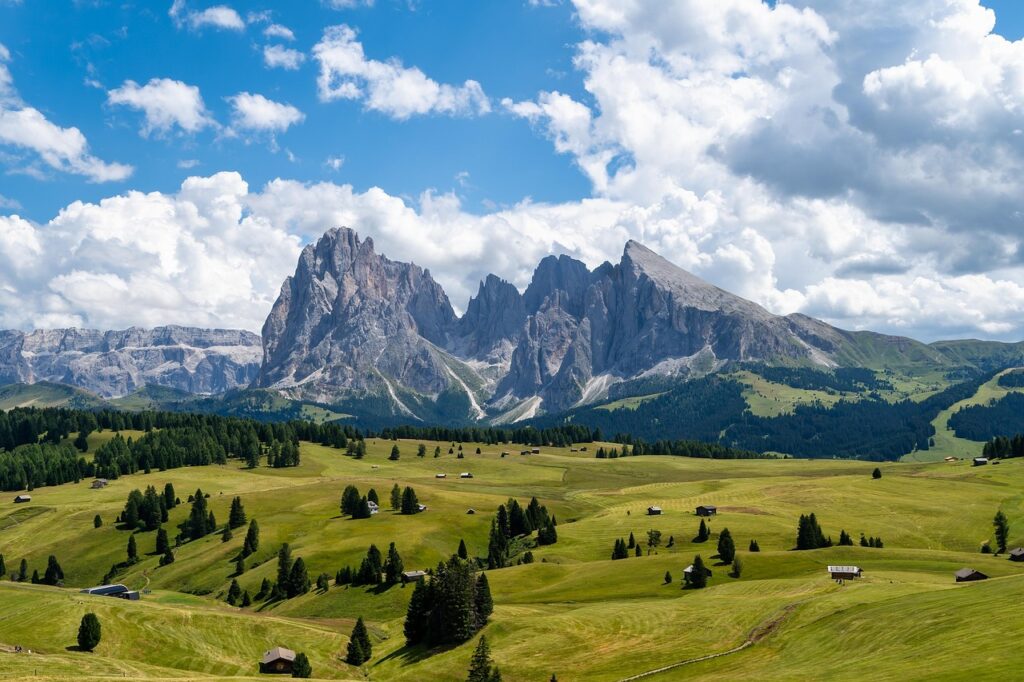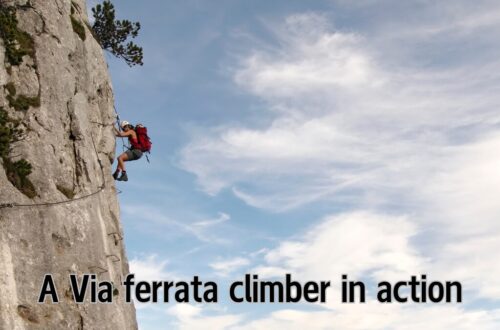Via Ferrata degli Alleghesi: An exciting Alpine Ascent of Monte Civetta
The Via Ferrata degli Alleghesi is high above the Agordino valley in the heart of the Dolomites. Monte Civetta is one of the most imposing and majestic peaks in northeastern Italy. Dominated by its sheer northwest face known as the “Wall of Walls,” it attracts mountaineers and climbers from around the world. If you are seeking an adventurous but non-technical way to climb this giant, the route offers a classic, high-altitude challenge with all the hallmarks of a great alpine journey.
This historic route ascends the north and northeast ridges of Monte Civetta. It is one of the toughest via ferratas in the Dolomites, not just for its technical sections but for its length, height, and remote alpine environment. For seasoned ferratists and fit adventurers, the Alleghesi is an unforgettable route to the top of one of the Dolomites’ most iconic summits.

Overview of Via Ferrata degli Alleghesi
- Location: Monte Civetta, Dolomites, Veneto, Italy
- Starting Point: Rifugio Coldai (from Alleghe)
- Summit Elevation: 3,220 meters (10,564 feet)
- Route Length: 1,200 meters vertical gain
- Estimated Time: 8 to 10 hours (ascent only), longer for round trip
- Difficulty: Difficult (C/D)
- Best Season: Mid-July to mid-September
This is not for beginner’s. The Via Ferrata degli Alleghesi demands stamina, good weather conditions, and prior experience with via ferratas or mountaineering. It is often done as part of a multi-day trip with an overnight at Rifugio Torrani near the summit.
Click here for a fantastic selection of European adventures.
Route Description
1. Approach to Rifugio Coldai
Most climbers begin the journey in Alleghe, a charming alpine village nestled below Monte Civetta. From here, you can either hike or take a cable car to Pian di Pezzè, then follow a marked trail to Rifugio Coldai (2,132 meters), perched near the scenic Lago Coldai. Many climbers stay here overnight to get an early start the next morning.
2. From Coldai to the Start of the Via Ferrata
From Rifugio Coldai, the path descends slightly before winding around the flanks of Monte Civetta, offering stunning views of the wall’s vertical face. After roughly an hour of hiking, you’ll reach the start of the ferrata route at around 2,300 meters.

3. Climbing the Alleghesi Ridge
The via ferrata itself begins modestly but quickly ramps up in steepness and exposure. The route follows the northeast ridge, sticking close to the natural line of the mountain. Sections of the climb have vertical and near-vertical cable-protected faces, narrow ledges, and airy traverses.
Though the technical difficulty rarely exceeds grade D, the exposure is sustained, and the route is long. One of the main challenges is keeping your concentration and energy throughout the climb. There are’nt many chances to rest, and the rock can be slippery in damp or humid conditions.
4. The Summit Push and Rifugio Torrani
As you near the top, the cables end, and the final section becomes a scramble over loose rock and scree. The summit of Monte Civetta is marked by a cross and offers panoramic views of the Marmolada, Tofane, Pelmo, and the distant Austrian Alps.
Just below the summit, climbers can find Rifugio Torrani (2,984 meters), one of the highest huts in the Dolomites. Small and rustic, it offers a basic but atmospheric overnight stay for those summiting late in the day or needing shelter from deteriorating weather.
You need to be in good condition for Via Ferratas. Click here to turbocharge you health and fitness.
Key Highlights of the Experience
1. Epic Views from Start to Summit
From the tranquil shores of Lago Coldai to the sweeping ridgelines of the Alleghesi and the high-altitude vistas from Monte Civetta’s summit, the visual rewards of this route are immense. The interplay of light and shadow across the Dolomitic limestone creates a surreal alpine landscape.
2. True Alpine Adventure
Unlike many shorter or more accessible via ferratas, the Alleghesi feels like a full-fledged alpine ascent. It takes you from green pastures through rocky ridgelines to a towering summit with ever-changing terrain and weather.
3. Rifugio Culture
The route connects a series of mountain huts, including Rifugio Coldai and Rifugio Torrani, allowing climbers to break up the climb, acclimatize, and enjoy local cuisine. The camaraderie of the rifugio system makes it even more fun..
Click here if you want a selection of stylish, practical and outdoors appropriate menswear.
Practical Considerations
Fitness and Preparation
You need high levels of endurance and physical fitness for this Via Ferrata. Expect a long day of strenuous climbing, especially if completing it in a single push from Coldai to the summit and back. Acclimatization is recommended.
Gear Checklist
- Certified via ferrata set (harness, helmet, lanyards with shock absorbers)
- Mountaineering boots or stiff-soled hiking boots
- Gloves for gripping cables
- Headlamp (especially if descending late)
- Weather protection: Windproof, waterproof jacket, insulating layers
- Food and water: There are no water sources on the route
- Map, compass, and/or GPS app
- Cash for rifugios
Route Timing
- Day 1: Alleghe to Rifugio Coldai (stay overnight)
- Day 2: Early start for the Alleghesi route; reach summit around midday; option to descend or stay at Rifugio Torrani
Descending from the summit typically involves the Ferrata Tissi or a long hike back to Alleghe. Both routes are tiring and need careful planning.
Best Season to Climb
Late July to mid-September offers the best conditions. Early snow can linger on the upper sections well into July. Always check with local guides or rifugios for up-to-date conditions.
Safety Considerations
- Start early to avoid afternoon storms
- Avoid attempting in bad weather—lightning and wet rock are deadly
- Have an emergency plan in case of fatigue or injury
- Solo ascents not recommended due to isolation and exposure
Click here for info about another Italian Via Ferrata.
Alternative Routes and Add-Ons
If you wish to extend your time in the Civetta area or take a slightly different route:
- Via Ferrata Tissi: Often used for descent, this shorter but still exposed route can also be done as an ascent.
- Alta Via 1: The Alleghesi intersects with the famous long-distance trail; consider combining part of the Alta Via into your journey.
- Rifugio Vazzoler and Capanna Trieste: Scenic lower-altitude rifugios that offer routes to the base of Monte Civetta.
If you would like to lose weight before attempting the Via Ferratas, click here.
Why Choose Via Ferrata degli Alleghesi?
The Via Ferrata degli Alleghesi is a legendary route that captures the grandeur and seriousness of true alpine climbing. It offers more than just fixed cables and stunning views—it provides a full mountain experience that combines physical challenge, technical exposure, and high alpine beauty.
For experienced climbers with good conditioning and proper planning, it is one of the most rewarding via ferratas in the Dolomites. Whether you’re climbing to bag one of the region’s most famous peaks or seeking the joy of moving through wild and vertical terrain, the Alleghesi will leave a lasting impression.
Would you like a printable topographic map or a multi-day itinerary that includes the Alleghesi and nearby routes?


